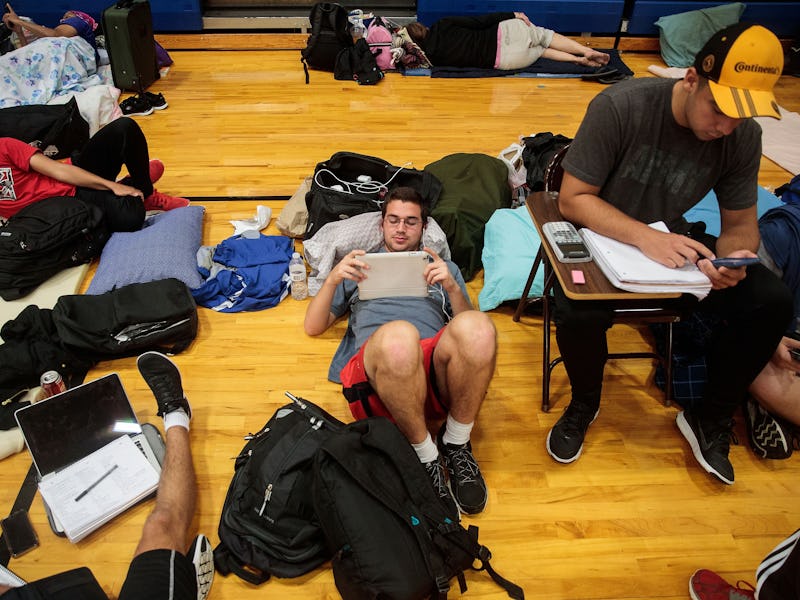5 Technologies That Are Changing High Schools Right Now
A science revolution is happening in schools.

The American high school is getting an upgrade.
For more than a century, high school has had the same basic formula: Eight hours of class, with each subject taught at a time. But technology is beginning to transform teens’ education experience both in and out of the classroom.
High schools’ embrace of tech is just one way that things are changing. Last year, it was revealed the 2014-15 school year set a record high of more than 83 percent of students earning a diploma on time, and extracurricular activities are expanding to encompass more students. For instance, Holly Neher, a 16-year-old from South Florida, made national news when she became possibly the first female quarterback in the state to throw a touchdown pass at a game.
The classrooms of old are changing at breakneck pace, getting more kids involved than ever. Here are five ways that schools are changing:
Let’s Start with Bathrooms
Fly Sense is a new gadget, designed to be placed in school bathrooms, that picks up unusual sounds. It doesn’t record audio or video, but it’s designed to alert teachers to students that may be getting bullied. Sounds like a door slamming or students yelling will send a message to administrators.
Fly Sense.
“Unfortunately this past spring a child was bullied in the bathroom, and then went home and killed himself. That happened in Ohio,” Derek Peterson from software engineering company Digital Fly, creators of the gadget, told Fox 17. “So anything we can do to save a life or get a return on education is a plus.”
Science Classrooms
Energy Day in Colorado.
Students in Colorado gathered at the inaugural Energy Day festival in September, as part of a new strategy to get more kids involved in science. Ditching the dusty textbooks of old, these initiatives are about demystifying STEM subjects by getting hands-on experience with practical applications.
“People need to know that building robots is not an impossible sci-fi thing,” Gregor Owens, electric captain of the East High School Angelbotics robotics team, told the Greeley Tribune in Colorado. “You can do it at home if you want. It’s doable. It’s easy.”
Classroom Floor
Tustin High School students working on a project.
Students from the Tustin High School InvenTeam in California have developed a device that can remove chewing gum from school floors. The system uses a biodegradable chemical solvent along with an electric heating element to loosen the gum, ready for a brass brush to remove without causing damage. The machine takes about 30 seconds to remove one piece of gum.
The team participated in the Lemelson-MIT Program, now in its 14th year, aimed at getting 15 teams of high school students interested in science and technology. Each team received $10,000 to solve a real-world issue with their invention. The program has been a great success, with 67 percent of InvenTeam college graduates now working in a STEM field.
Gadget Shows
Clark County School District high school students in Las Vegas have worked together to devise three big ideas that they plan to present at next year’s annual Consumer Electronics Show. The inventions include a laptop that mirrors the smartphone, a cube that performs household tasks, and a stress-relieving app.
The winners were picked from a list of around 20 teams, and were judged by a panel in Vegas. Other ideas that didn’t make the cut include an edible stick for lollipops and sweat-absorbing tape for video game controllers.
“I think this really takes what they’re learning in the classroom and helps them apply it in a real-life setting,” Snehal Bhakta, Clark County School District career and technical education lead, told the Las Vegas Review-Journal.
Gamification of Learning
Duolingo in action.
Duolingo has popularized the idea of making language learning into a game, and the app offers special tools for teachers to build the site into their lessons. But some teachers are taking these same ideas of incentivizing students and using them for other classes, giving that same rush of completing a level to everyday lessons.
Professional learning site TeachLearning has produced 10 strategies to incorporate these ideas into lessons. One such example is a progress bar, similar to those found on Xbox or Steam that show how far a student has to go before reaching their goal.
“Kids love seeing visible progress,” the site explains. “In fact, we all do.”
It’s an impressive array of technologies, but it’s only the start. Be sure to take a look at these 14 futuristic schools that are taking technological advances to a whole new level.
If you liked this article, check out this video on making a bionic eye.